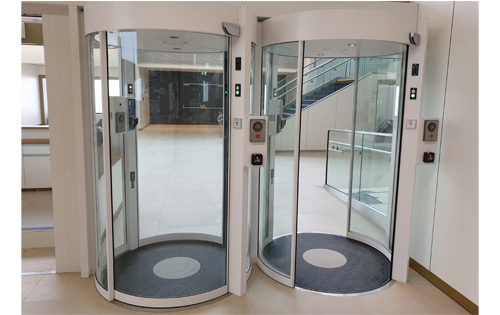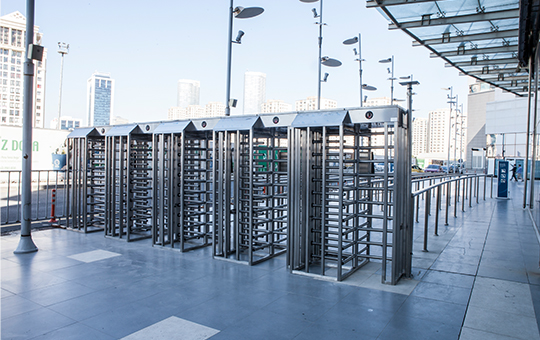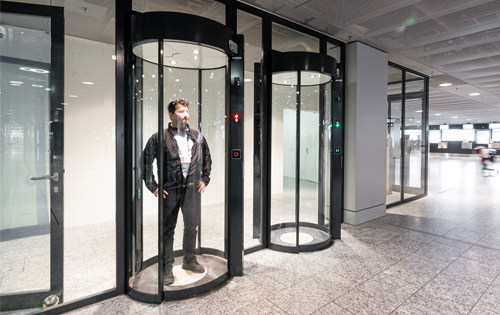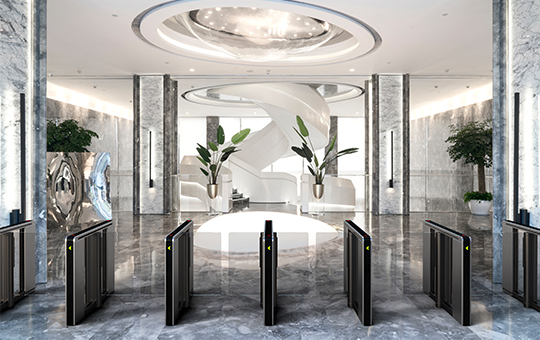Anti Tailgating and Piggybacking for Secure Areas
The word tailgating originates originally from the US where one car follows too closely behind another. In the security industry it is where someone without the appropriate security credential tries to follow someone through a security controlled door. Of course, in traffic, tailgating can cause a serious accident. In the security industry the risk is not so much physical to the person being followed but to the assets being protected by the access control solution. And I think we all know what piggybacking is!
This article will talk briefly through the various solutions and their effectiveness in stopping tailgating/piggybacking and its associated risk, side-gating. There are 2 aspects to preventing tailgating. By the way. this article only addresses automated, electro-mechanical devices. So, the 2 means to counteract tailgating/piggybacking are:
- Electronically notifying security that security has potentially been breached
- Physically preventing the tailgater from succeeding

Electronic Anti-tailgating measures
There are 3 main means of electronic anti-tailgating measures:
- Sensors
- Contact Mats
- Time of Flight cameras
Sensors
Sensors come in all shapes and sizes and have various uses. We are here only interested in the security sensors not the safety sensors.
- Tailgating sensors. These sensors are typically mounted horizontally in speedlanes or vertically (on doors – see below) to ‘watch’ the progress of a person through an entrance. The more basic technologies are just beams that are ‘broken’ to show progress through the entrance and to detect if more than one person is going through. These are very prone to false alarms for example if someone turns around in the entrance or swings a bag or umbrella.
The more sophisticated technologies can track a person through a lane, know that that same person turns and steps back momentarily and even detect if they are in a wheelchair, pushchair etc. and/or carrying or bag. The latest technologies can even detect 2 people walking next to each other, so-called side-gating. Most systems can detect tailgating if there is at least a 5mm gap between the person in front and the one behind.
- Action specific sensors. These sensors are used in addition to the tailgating sensors and for example can detect someone crawling under, jumping over, pressure and for example if they are pulling a trolley bag behind them.
Contact Mats
Contact mats are used in Security Mantrap portals and Security Revolving doors to detect if more than one person is inside the unit. They can be deceived by piggybacking, hence the need for time of flight cameras (see below) if you wish to detect piggybacking. They can detect weight although this feature tends to have limited use. Their main use is to identify that there is only one pair of feet in the designated space. In conjunction with a time of flight camera contact mats are the most secure methodology for preventing unauthorised pedestrian access.

Time of Flight Cameras (ToF)
ToF cameras are a sophisticated technology that use infrared light to ‘map’ an area. Using these cameras, systems can detect the presence of more than one person in a given space. They are not foolproof as they have a certain range: Too close and they won’t work, too far away and they won’t work. This is the only technology that will detect piggybacking as it comes from above but of course there are also ways to confuse the ToF camera. No device is 100% effective and nor is any human.
All the above sensors can be integrated into various pedestrian security products to enhance the effectiveness of the pedestrian barrier. I’ll briefly describe each one and its pros and cons: Security Level, Flow and Price.
Physically preventing tailgating
There are 3 main pedestrian security products aimed at physically preventing tailgating.
- Full Height mechanical turnstile
- Security (Mantrap) Portal
- Security Revolving Door

These are the most cost-effective means of physically preventing tailgating. They come in either 3 arm or 4 arm versions and are extremely effective. If price is key this is the option to go for. As a bonus they are also the only product in the whole range that are fully outdoor rated for all weathers so are suitable for example for perimeter security. Note however that they are not the very highest security level and that it is theoretically possible to piggyback or for 2 small people to successfully breach a full height turnstile, albeit unlikely. The flow through this product is mid-range, 10-12 people a minute.
Security (Mantrap) Portal (SMP)
The SMP is a highly effective means of preventing tailgating but without either contact mats or ToF technology (see above) it doesn’t in and of itself prevent tailgating. The first level of threat mitigation is the contact mat but as described above these do not prevent piggybacking. If you want the highest level of security then a ToF camera AND a contact mat along with (of course) the access control device is the highest level for a pedestrian security product. Price and flow are on a par with Security Revolving Doors in practise. They come in many shapes and sizes and there are even ones for bikes.

.jpg)
The SRD comes in 2 versions in a security setting, 3 and 4 wing. (2 wing revolving doors exist but they are not useful for security settings for various reasons we don’t have the space to go in to here.) The 4 wing revolving door is the more secure as there always at least 2 panes of glass to break through because of the geometry of the glass wings. These can be installed with contact mats and ToF cameras like with the SMP’s but you could argue that without either of those they do offer a higher level of security as (like with the full height mechanical turnstile) it is quite difficult for 2 people to follow through behind each other in the same quadrant in the smaller SRD’s which are typically used with access control devices. As mentioned above, price and flow are in reality on a par with the SMP’s although there is an ongoing debate with regards the flow rate of the SRD.
Speed Gate / Speedlane / Optical Turnstile
Speedlanes come in all shapes and sizes but fundamentally they use the anti-tailgating technology to detect tailgating. The price of a speedlane is generally contingent on the sophistication of the tailgating technology amongst other things. Speedlanes, in terms of cost, are the mid-way point between full height turnstiles and SMP’s & SRD’s. They offer however a considerably higher level of throughput at 30-40 people a minute. These are the product of choice in one form or another for most businesses due to the ‘sweetspot’ combination of cost versus security level.

Anti-tailgating for Standard doors
A key vulnerability in any building is the standard door. Of course, with access control it is secure until someone with a valid credential opens that door. Now either because people are friendly or they are deliberately trying to fool the system, the access control has done all it can. There are a range of products that work much like a speedlane but the technology is mounted vertically on the sides of the door instead of horizontally like on the speedlane. The only difference is that they offer no physical barrier unlike a speedlane. But even with speedlanes they are not allowed to crush people so you could argue that they are almost as effective as a speedlane and considerably cheaper. These systems can however be linked to in-house CCTV systems and set off alarms to alert security that unauthorised access might have taken place but as mentioned offer no physical barrier to people trying to get around the system.
Conclusion
There is no technology that is as good as a human presence and even they have their fallibilities. They fall asleep, need toilet breaks and frankly also just make mistakes. Security is always a compromise. How much do you want to spend? What is the risk you are trying to mitigate?
- Stephen Goodridge, SEC Business Development Manager, Record UK




